
The Pentagon said that it would choose contenders for Deputy Defense Secretary Kathleen Hicks' Replicator initiative this week, but DoD has not released those candidates yet. "We remain on plan, with the deputy secretary of defense approving recommendations this week," Eric Pahon, a spokesman for Hicks, wrote in a Dec. 19 email. Defense Daily has reached out to staffers on Capitol Hill, think tank analysts, and industry representatives and received no responses on which companies DoD has picked. Hicks told…














